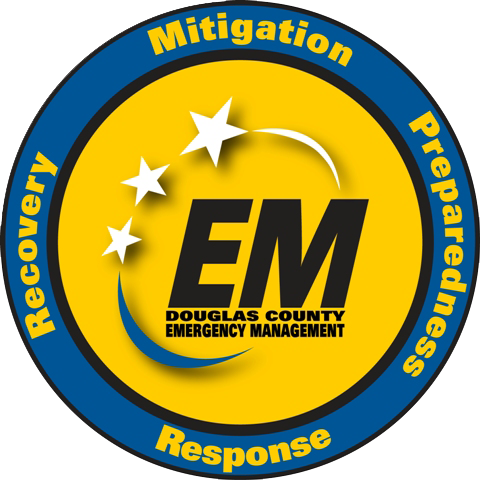Emergency Management
Emergency Preparedness for Individuals and Households
Each person has a role to play in preparedness. Follow the steps below to prepare yourself and your household for an emergency.
Step 1: Identify the Hazards
Dangers affecting Douglas County can be placed into four categories: Natural Disasters, Chemical Emergencies, Terrorist Attacks and Public Health Emergencies.
Decide what could affect you or your family. Think about how different hazards would impact your daily life. Identify what steps you could take to minimize the effects of certain hazards, such as installing and checking smoke detectors and washing your hands.
Step 2: Create Your Emergency Plan
It's important to know what to do when disaster strikes! Create a plan your whole family can use. Every member of the family needs to be involved so that when disaster strikes, everyone will know what to do, and how to keep in touch. How well you manage the aftermath of a disaster depends a great deal on how well you prepare today. In most emergencies, you will need to be ready to either GO (evacuation) or STAY (sheltering-in-place). Plan for both possibilities.
For All Emergencies
- Identify How to Get Emergency Alerts
- Have more than one way to receive emergency alerts. This might include:
- NEKS Regional Notification System
- Wireless Emergency Alerts
- NOAA Weather Radio
- Outdoor Warning Sirens
- Douglas County Emergency Management Social Media
- Local radio and TV
- Have more than one way to receive emergency alerts. This might include:
- Contact Information and Communication Plan
- Everyone in your family or household should have everyone else’s work, school, and cell numbers.
- Out-of-town contact: What is an out-of-town contact? A friend or family member who would not likely be involved in the same emergency or disaster as you. This is who you call if you can't reach your family. During a local emergency, it may be easier to call someone out of state than someone in town.
- Have a plan for communication and checking in with each other in the event of an emergency.
- Remember: Everyone must know and understand the plan for it to work. Practice your plan frequently and update it when anything in your plan changes.
Go: Evacuation
- Evacuation Plan:
- Do you know what to do if you have to leave work early due to severe weather, fire, or hazardous material spill? What if you have children in school who will need to leave early due to an emergency?
- What if you must leave your home because of an emergency? Do you have multiple routes to take out of your neighborhood? Don’t forget to think about your pets.
- Include answers to these questions in your Evacuation Plan.
- Include a map of your home locating all the exits.
- Two Family Meeting Places:
- One outside your home in case of fire. This could be in your neighbor's yard or across the street.
- One outside your neighborhood in case you can't get home.
Stay: Shelter-In-Place
- Identify where you will shelter in the event of severe weather, whether you are at home, work, or another place you frequent. Learn more about severe weather sheltering here.
- Some chemical emergencies may require you to shelter-in-place. Learn more about hazardous materials sheltering here.
Step 3: Make Your Preparedness Kit
Emergencies can happen without warning, so having the supplies you'll need for three days will help keep your family safe. Gather the materials below and place them in easy-to-carry containers. Store your preparedness kit in your severe weather sheltering area. Make sure your kit, or at least the most essential items, would be easy to carry to a vehicle in case you need to evacuate. Your kit should include 3 days of supplies for everyone in your family - even your pets! Check your kit at least once a year to make sure the items are still good. Kit items include:
- Water (1 gallon per person per day)
- Radio (AM/FM and NOAA All-Hazard Radio)
- Flashlight with extra batteries
- Glow sticks (optional)
- First Aid Kit
- Medications (including any prescriptions)
- Personal Hygiene Items (Soap, deodorant, wet wipes, etc)
- Alcohol-based hand sanitizer
- Whistle (Why? Whistles can be heard better and can be done longer than yelling)
- Eyeglasses, inhaler, contacts, wheelchair, or other essential items
- Nonperishable foods like canned foods, peanut butter, crackers and pet food (if you have a pet). Include anything you need to open the food, like a can opener.
- Changes of clothing based on season, including hard soled shoes (not just flip-flops)
- Small amount of cash or credit card
- Blankets or sleeping bags
- Indoor game or book for you to play with or read
- Copies of important documents like bank statements, insurance cards, driver's licenses, birth certificates. These can be hard copies or electronic, stored on a memory stick.
Judicial and Law Enforcement Building
111 E 11th St
Lawrence, KS 66044
United States

